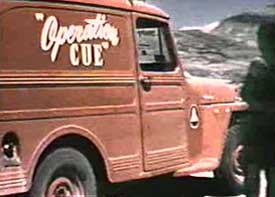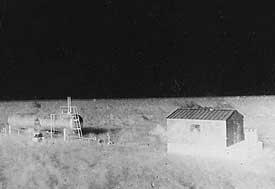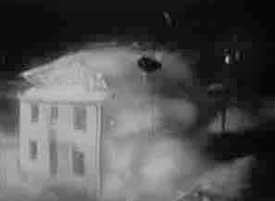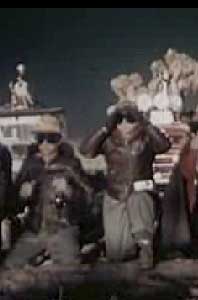 Operation Cue (1955) begins with a bland lecture on the comparative destructiveness of A bombs measured in kilotons & H bombs measured in megatons, citing an A bomb capable of destroying everything in a one-mile radius vs an H bomb capable of the same degree of destruction in an eight & a half mile radius. Operation Cue (1955) begins with a bland lecture on the comparative destructiveness of A bombs measured in kilotons & H bombs measured in megatons, citing an A bomb capable of destroying everything in a one-mile radius vs an H bomb capable of the same degree of destruction in an eight & a half mile radius.
This information is delivered with as much understatement as the monotone narrator can make of it, but the implications are pretty clear, & more starkly assuring of complete doom than any other Civil Defense film.
And yet the color film that follows will often contradict the bland assertions of unutterable anihilation of everything for miles around each & every bomb, in favor of the notion that nuclear holocaust is survivable. It's a whole lot more about placating the plebian hordes than about preparing citizens for potential crisis.
Another change in the usual method of delivering this propaganda is the manner by which the authoritative male voice shares the script with a woman's voice, she purporting to be an investigative reporter covering Operation Cue at the Nevada test site. The pretense of independent investigation is supposed to fool the viewer into not remembering this is strictly a government film.
The professional but definitely not authoritative female voice of "Joan Collin" carries the weight of her pretended profession without it seeming as desparate as if a deep masculine voice was admonishing & instructing us as in most such films from the era. By posing her faux-journalistic queries to the masculine voice, she becomes the Voice of the Masses trusting of & subservient to military authority.
 So we're being importantly instructed through the point of view of Joan as an "independent" investigative eye, though in reality she's an actress, & no more an independent reporter than Ignatz or Crazy Cat. So we're being importantly instructed through the point of view of Joan as an "independent" investigative eye, though in reality she's an actress, & no more an independent reporter than Ignatz or Crazy Cat.
The stated purpose of the test was to show the effect of a nuclear bomb "on the things we use in our everyday lives." Buildings of sundry construction materials are built at intervals from the flashpoint for the bomb, stocked with sundries, & given a population of mannikens.
It takes forever to reach the ten minute mark of the film, when at last we get far too few images of the various test buildings blown to bits. Afterward Joan has the damage explained to her in terms that make it seem like Americans don't have to worry, because even if they didn't have an underground fallout shelter, the reinforced concrete shelter among the test buildings is still standing, thus citizens can survive. And never mind that the reinforced windows were blown off & structure was completely blasted inside.
Better still, one dummy-family placed in a "reinforced bathroom" also survived. Therefore you too can survive nuclear holocaust if only you can spend the duration in a concrete bunker or have a specially constructed bathroom such as no one in the 1950s ever had. Not that it'd actually do any good if they did.
The tests presumedly proved nuclear holocaust was no big deal. One dummy had the outer layer of his dark suit faded, so count on needing a new suit if you get blasted by an atomic bomb.
The dissonance between seeing buildings completely destroyed or gutted, & seeing that if we live in reinforced bunkers the bunkers at least will survive even if nothing inside them could, just doesn't match up to what the narrative is insisting has been proven.
And even if they hadn't been lying their arses off, where was the government program to turn everybody's houses into concrete bunkers with reinforced bathroom shelters? No wonder the '50s were so paranoic if this is what passed as reassurance.
 The fake reporter Joan Collins is not named in the 1964 re-edit & revision titled Operation Cue (Revision).
The fake reporter Joan Collins is not named in the 1964 re-edit & revision titled Operation Cue (Revision).
The new introduction admits the 1955 film understated the severity of the effects of the bomb, an admission that is apparently supposed to make the same lies reframed sound more convincing since it starts off so honest.
There are minor alterations of the text, but in the main the same film unfolds, ending with the same happy cook-out of the sort that's supposed to happen if everybody's houses are blown to smithereens & we all have to eat outside like happy campers.
It's curious anyone bothered to re-edit the film for re-release, as one of the key propagandistic intents in 1955 was to convince the public there were sound construction materials suitable for fallout shelters. By 1964 the government was no longer promoting shelters.
Operation Cue was one of the smaller in the series of "Operation Teapot" tests in Nevada. Mostly this operation was orchestrated to appeal to the press, & was the largest test site ever built specifically to put on a show for civilians. Of course, nowhere in the film do they admit this is an expensive publicity event.
Reporters, regional politicians, & miscellaneous civillians designated "volunteer civil defense workers" were irradiated along with military personel. Reporters were never informed how much radiation they were exposed to, & that information is classified to this day.
A hydrogen bomb would be 250 times more powerful than the bomb observed. Nevertheless with handlers instructing the reporters on what they were supposed to see, most of them came away convinced a nuclear bomb was survivable, & committed themselves to promoting the Department of Civil Defense as good & wise & requiring abject obedience at all times.
But not trusting the reporters would tell it as preferred, the military made their own film with the actress pretending to be a reporter. As such, the test was called an "observer program" & it concluded with a picnic made of foods that had been part of the test because how Public Relations savvy is that.
Since the food still tasted like food, it was evidence that everything would be fine for whoever survives the initial blast. And a good time was had by all.
copyright © by Paghat the Ratgirl
|


 So we're being importantly instructed through the point of view of Joan as an "independent" investigative eye, though in reality she's an actress, & no more an independent reporter than Ignatz or Crazy Cat.
So we're being importantly instructed through the point of view of Joan as an "independent" investigative eye, though in reality she's an actress, & no more an independent reporter than Ignatz or Crazy Cat.